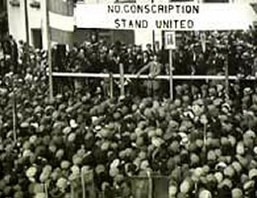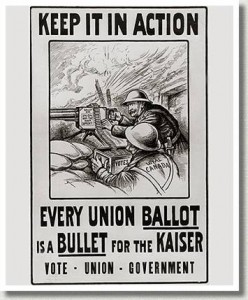The Canadian army relied on volunteers for most of the war. Many young men were excited at first at the idea of fighting for their country They rushed to volunteer in their enthusiasm to get overseas.
The horrors of the trenches soon changed this enthusiasm. From 1915 to 1917, Canadian soldiers gained a high reputation for courage. As a result, they were often chosen for the toughest and most dangerous assignments during battles.
Canadians fought at Vimy Ridge in April, 1917. That month over 10,000 Canadian soldiers died but fewer than 5,000 volunteered to join the army. The volunteer system was not recruiting enough soldiers to replace the losses.
Prime Minister Robert Borden had promised that his government would not introduce conscription. It would not force men to join the army. Now he had to break that promise. He called an election to prove that conscription was the “will of the people. This campaign was one of the fiercest and angriest in Canadian history.
People Against Conscription
 The largest group against conscription was the French Canadians. When the war started, many volunteered to enter the army. The Royal 22nd Regiment, the “VanDoos” (from vingt-deux), was a French-speaking unit. It had a great fighting record right through the war.
The largest group against conscription was the French Canadians. When the war started, many volunteered to enter the army. The Royal 22nd Regiment, the “VanDoos” (from vingt-deux), was a French-speaking unit. It had a great fighting record right through the war.
The minister of militia at the war’s beginning was Sam Hughes, an Irish Protestant. Hughes did not try to understand the position of the French-Canadians. He hated Roman-Catholics. He sent Protestant clergymen as recruiting officers to Québec. He insisted the French soldiers be trained in English. Borden fired Hughes in 1916 but it was too late to save the situation in Québec.
French Canadians had not supported Britain during the Boer War. Some felt the same way now. They were being asked to defend Britain, not Canada. Former Prime Minster Wilfred Laurier, Leader of the Opposition during the war, did not feel this way. He urged French Canadians to join the army but he did not think they should be forced to do so.
In the West, many settlers objected to conscription. They had moved to Canada to get away from European wars. In many countries, governments could force men into the army. They thought they had escaped that way of life. Now it seemed to be coming to Canada.
Farmers everywhere objected to conscription. Their part in the war effort was to provide much-needed food. Who would work with them if their sons were taken away?
What the Government Did
Prime Minister Borden was convinced that conscription was necessary. Those in favour of conscription had to win the election to justify breaking his earlier promise First, Borden asked Laurier to join him in a coalition or union government. Laurier could not do this. Although he supported the war effort, he was against conscription. Borden approached other Liberals. Some of them were for conscription. Several Liberals joined the Conservatives in a new party. They called it the Unionist Party.
The Election of 1917
 To increase his chances of reelection, Borden forced two bills through the House. The Military Voters Act extended the vote to all members of the armed forces, both male and female. This meant that women who worked as nurses or ambulance drivers for the CEF could vote in federal elections. The Wartime Elections Act gave the vote to mothers, wives, daughters, and sisters of men serving overseas. This controversial law also denied the vote to conscientious objectors and Canadians born in enemy countries, such as Germany.
To increase his chances of reelection, Borden forced two bills through the House. The Military Voters Act extended the vote to all members of the armed forces, both male and female. This meant that women who worked as nurses or ambulance drivers for the CEF could vote in federal elections. The Wartime Elections Act gave the vote to mothers, wives, daughters, and sisters of men serving overseas. This controversial law also denied the vote to conscientious objectors and Canadians born in enemy countries, such as Germany.
The Unionists won the election with 153 seats; the Liberals had only 82. Only 20 of those 82 seats came from outside Québec but the results did not show the true feelings of the people. Many English-speaking Canadians did not want conscription either. In fact, if the soldiers’ votes were omitted from the polls, nearly half the people voted against mandatory conscription.
The conscription issue aroused many bitter feelings. In Québec, there were bloody riots. Borden’s wartime victory cost the nation dearly. It took decades for the people of Québec to forgive the Conservative Party for instituting conscription.
